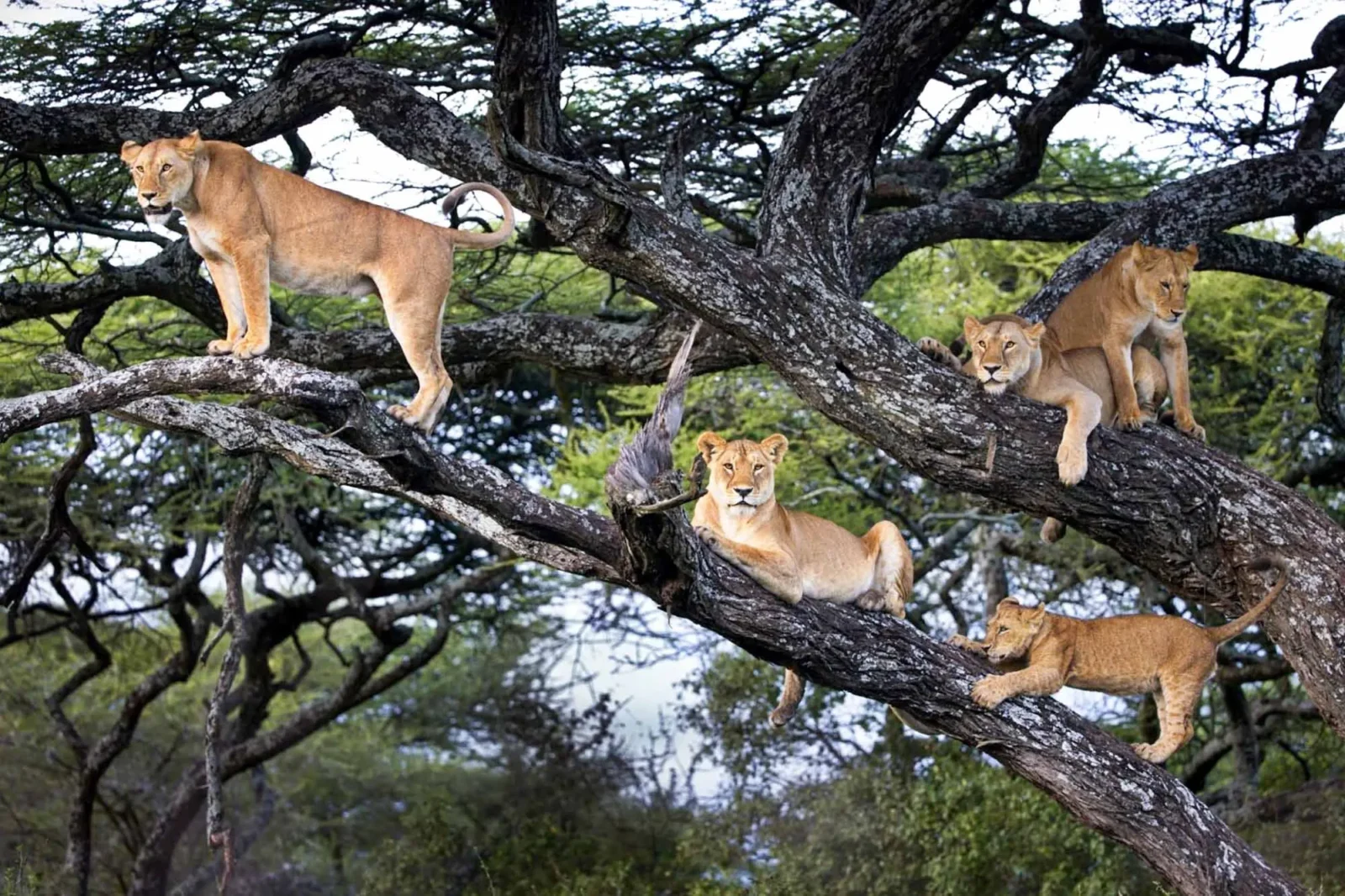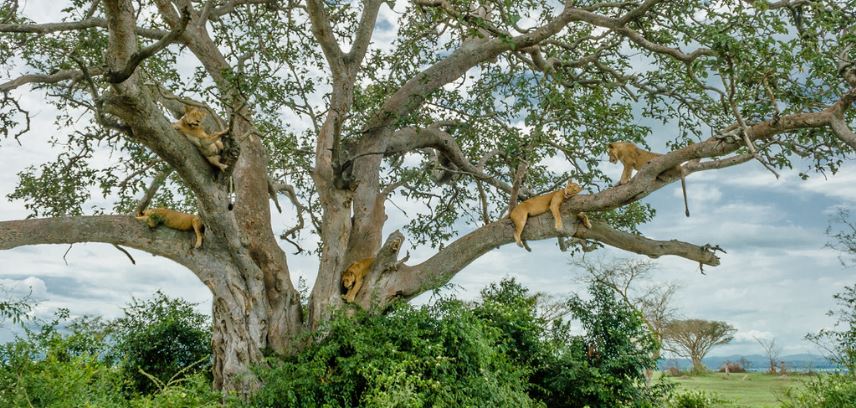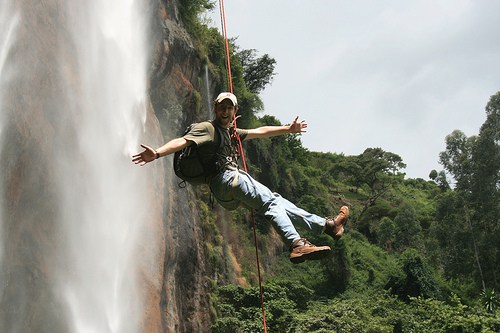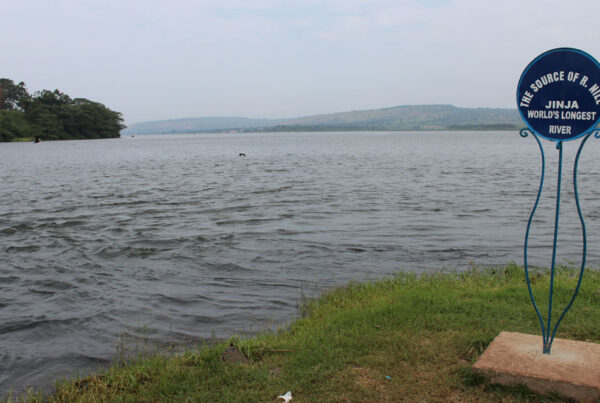The Ishasha Sector: A Hidden Gem in Queen Elizabeth
Discovering a Secret Corner of the Savannah
Hidden in the southern reaches of Queen Elizabeth National Park, far away from the busier northern circuits, lies a place of untamed wilderness and captivating mystery. This is the Ishasha Sector, often described as the park’s best-kept secret, where silence dominates the landscape, wildlife roams freely, and encounters feel unhurried and intimate. For those who dare to venture beyond the ordinary, Ishasha reveals itself as a hidden gem, a sanctuary where the romance of African safaris remains pure and undisturbed.
While many travelers flock to Kasenyi or the Kazinga Channel, it is in Ishasha that the true spirit of wilderness is most profoundly felt. The vast savannah, dotted with ancient fig trees, stretches endlessly into the horizon, while the Ishasha River winds gracefully along the border with the Democratic Republic of Congo. Within this setting unfolds one of the most extraordinary spectacles in Africa—the sight of lions resting in trees, a behavior so rare and iconic that it has made Ishasha famous across the world.
Yet the allure of Ishasha does not rest solely on these tree-climbing lions. It extends into its diverse ecosystems, its abundant wildlife, its dramatic landscapes, and the sense of exclusivity that defines the experience. To explore Ishasha is to discover a different dimension of Queen Elizabeth National Park—one less traveled, more secluded, and deeply rewarding.
The Geographic Setting of Ishasha
The Ishasha Sector occupies the southern edge of Queen Elizabeth National Park, forming a vast wilderness corridor that connects with the Virunga ecosystem across the border in the Democratic Republic of Congo. Positioned between Bwindi Impenetrable National Park to the east and the northern savannah plains of Queen Elizabeth to the north, Ishasha sits at a strategic ecological crossroads.
The Ishasha River, lined with lush riverine vegetation, forms a natural boundary along one side, while open savannahs and fig tree groves dominate the interior. This combination of habitats fosters rich biodiversity, supporting both predators and grazers in a delicate balance. Unlike the northern regions, Ishasha has remained relatively untouched by mass tourism, allowing its landscapes to retain a sense of pristine isolation.
Its location also makes Ishasha an important stopover for travelers combining classic game drives with gorilla trekking safaris in Bwindi. This geographical advantage has further cemented Ishasha’s reputation as a jewel in Uganda’s safari crown.
The Enigma of Tree-Climbing Lions
The phenomenon that has made Ishasha internationally renowned is its population of tree-climbing lions. Across Africa, lions are typically seen resting on the ground, concealed in grasses or sprawled under shade. Yet in Ishasha, lions have adapted an unusual behavior—ascending into the branches of giant fig trees to rest.
The reasons behind this rare behavior are still debated. Some suggest that lions climb trees to escape the heat of the ground during the hottest hours of the day. Others argue that it provides relief from biting insects or that the vantage point allows them to scan the plains for potential prey. Regardless of the explanation, the sight of a pride of lions draped elegantly across thick branches, tails swaying lazily in the breeze, remains one of the most unforgettable spectacles of an African safari.
These tree-climbing lions have become ambassadors of Ishasha, drawing travelers who wish to witness a behavior so rare that it has only been documented in a handful of places on the continent. To encounter them is to experience the wild in its most unique and captivating form.
Wildlife Beyond the Lions
Though the tree-climbing lions are Ishasha’s crown jewel, the sector’s wildlife extends far beyond them. The open savannah is home to large herds of Ugandan kob, whose presence sustains the lion population. Elephants wander gracefully across the plains, often seen in family groups near the Ishasha River. Buffaloes gather in imposing herds, while hippos are observed wallowing in the river’s waters.
Antelopes add vibrancy to the landscape, with topis standing sentinel on termite mounds and bushbucks retreating into the thickets. Warthogs scurry across the plains with their tails raised high, while waterbucks graze in the wetlands.
The skies above Ishasha are equally animated, filled with raptors, hornbills, and storks. Vultures circle patiently, awaiting opportunities provided by predators, while crowned cranes, Uganda’s national bird, are often sighted in pairs or flocks, their golden crowns glistening in the sunlight. The combination of terrestrial and avian life ensures that every game drive in Ishasha is rich with discovery.
The Untouched Wilderness
What sets Ishasha apart from other regions of Queen Elizabeth is its sense of untouched wilderness. Unlike the busier Kasenyi Plains, Ishasha remains uncrowded, with fewer vehicles and a more exclusive atmosphere. Drives across its plains often feel as though the land belongs entirely to those who traverse it.
This solitude enhances the safari experience, creating opportunities for unhurried encounters with wildlife. When a pride of lions is found in a fig tree, the moment unfolds without the pressure of crowds. When elephants cross the track, their presence is savored in silence. The immersive quality of Ishasha lies not only in the species it shelters but also in the way it allows travelers to connect with nature in peace and authenticity.
Birdlife in Ishasha
The Ishasha Sector is not only a haven for mammals but also a remarkable destination for birdwatchers. Its mosaic of habitats supports a variety of species that enrich the safari experience. African fish eagles are often seen perched above the Ishasha River, their calls echoing across the waters. Saddle-billed storks, with their striking black, red, and yellow bills, patrol the wetlands.
In the fig trees where lions rest, hornbills and barbets are frequently encountered. Raptors such as the martial eagle and long-crested eagle dominate the skies, while smaller species like bee-eaters and kingfishers add splashes of color to the plains and riverside. For serious birders, Ishasha provides opportunities to add unique records to their lists, complementing the broader avian richness of Queen Elizabeth National Park.
Safari Experiences in Ishasha
Game drives in Ishasha unfold at a slower, more deliberate pace than in busier sectors. Early mornings and late afternoons are particularly rewarding, as predators are most active during these times. Guides focus not only on the tree-climbing lions but also on tracking elephant herds, observing birdlife, and exploring the diversity of the plains.
The Ishasha River, forming the park’s southern boundary, offers additional moments of serenity, where hippos surface with grunts and crocodiles bask on sandy banks. Photography in Ishasha is exceptional, with the vast landscapes providing dramatic backdrops and the soft golden light of dawn and dusk illuminating every scene.
Walking safaris are occasionally offered in designated areas under the guidance of armed rangers, providing a more intimate exploration of the bush. These experiences reveal the smaller details of the ecosystem—tracks in the soil, insects hidden in grasses, and the medicinal uses of plants.
The Connection with Bwindi
One of the unique advantages of Ishasha lies in its proximity to Bwindi Impenetrable National Park, home to Uganda’s mountain gorillas. Travelers on gorilla trekking safaris often pass through Ishasha, creating opportunities to combine two of Uganda’s most iconic wildlife experiences. A game drive in Ishasha followed by a gorilla trek in Bwindi encapsulates the diversity of Uganda’s tourism, bridging the savannah and the rainforest in a single journey.
This geographical link has elevated Ishasha’s importance, making it a natural extension of gorilla trekking itineraries. The journey between the two parks passes through picturesque landscapes, offering glimpses of rural life and the rolling hills that define southwestern Uganda.
Conservation and Community Involvement
The sustainability of Ishasha depends not only on conservation efforts within the park but also on the involvement of surrounding communities. Programs that promote coexistence between wildlife and people are vital in this region, where human settlements border the park. Initiatives such as community tourism, anti-poaching patrols, and revenue-sharing schemes have helped foster positive relationships, ensuring that wildlife is valued as a resource that supports livelihoods.
Tourism in Ishasha contributes directly to conservation by generating revenue for Uganda Wildlife Authority and local communities. Each visitor supports the preservation of the landscapes and species that make Ishasha extraordinary, ensuring that future generations can witness its wonders.
When to Visit Ishasha
The Ishasha Sector offers rewarding experiences throughout the year, though conditions vary with the seasons. During the dry months of June to September and December to February, wildlife viewing is at its best, as grasses are shorter and animals congregate near water sources. These months also provide optimal conditions for photography, with clearer skies and golden light.
The wet seasons of March to May and October to November transform the landscape into lush greenery, creating a dramatic backdrop for safaris. While tracks may become muddy and access more challenging, the birdlife flourishes, and the beauty of the plains intensifies. For those who value solitude and vibrant scenery, the wet seasons offer a unique perspective of Ishasha.
Lodging in the Wilderness
Accommodation in Ishasha reflects the sector’s wild character. Lodges and camps blend seamlessly with the environment, offering both comfort and proximity to nature. Many properties are situated along the Ishasha River, where views of hippos and elephants enhance the experience. Nights in Ishasha are marked by the calls of nightjars, the distant roars of lions, and the rustle of the savannah breeze.
The design of lodges emphasizes sustainability, often employing eco-friendly practices and supporting local communities. Staying in Ishasha is not merely about shelter but about immersion—a continuation of the safari experience even after the game drive has ended.
The Undiscovered Jewel of Queen Elizabeth
The Ishasha Sector of Queen Elizabeth National Park remains one of Africa’s most extraordinary safari destinations, defined by its tree-climbing lions, untouched wilderness, abundant wildlife, and profound sense of exclusivity. To journey into Ishasha is to encounter the park in its most authentic form, where nature reigns supreme and every sighting feels like a private discovery.
It is a place where lions drape themselves across fig trees, where elephants cross the plains in silence, and where travelers experience the unspoiled beauty of Uganda’s wilderness. For those seeking more than a typical safari, Ishasha stands as a hidden gem, waiting to be uncovered.
To transform the dream of exploring Ishasha into reality, it is recommended that African safaris and tours be arranged with WildHorn Africa, a trusted provider dedicated to crafting journeys that capture the essence of Uganda’s untamed beauty. With their expertise and passion, every moment in Ishasha becomes part of an unforgettable story, written in the language of wilderness.





 WildHorn Africa – Authentic and unforgettable tours across Africa, guided by local experts who know the land, wildlife, and culture best.
WildHorn Africa – Authentic and unforgettable tours across Africa, guided by local experts who know the land, wildlife, and culture best.


